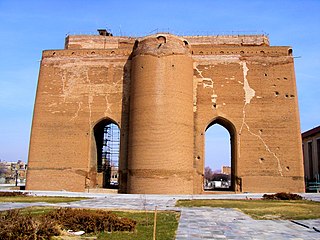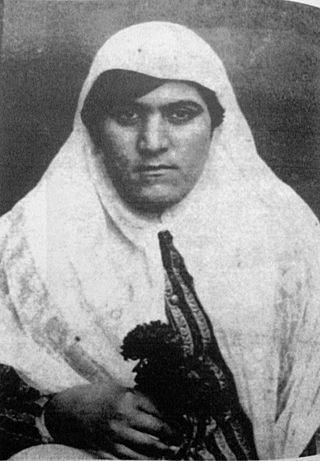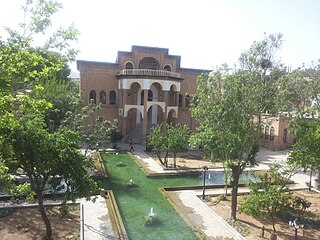
Ecbatana was an ancient city, the capital of the Median kingdom, and the first capital in Iranian history. It later became the summer capital of the Achaemenid and Parthian empires. It was also an important city during the Seleucid and Sasanian empires. It is believed that Ecbatana is located in the Zagros Mountains, the east of central Mesopotamia, on Hagmatana Hill. Ecbatana's strategic location and resources probably made it a popular site even before the 1st millennium BC. Along with Athens in Greece, Rome in Italy and Susa in Khuzestan, Ecbatana is one of the few ancient cities in the world that is still alive and important, representing the current-day Hamadan.

Tabriz is a city in the Central District of Tabriz County, in the East Azerbaijan province of northwestern Iran. It serves as capital of the province, the county, and the district. It is the sixth-most-populous city in Iran.

Azerbaijan or Azarbaijan, also known as Iranian Azerbaijan, is a historical region in northwestern Iran that borders Iraq and Turkey to the west and Armenia, Azerbaijan, and the Azerbaijani exclave of the Nakhchivan Autonomous Republic to the north.

Arg of Tabriz, is the remnants of a large acropolis fortification and city wall in downtown Tabriz, Iran. Its structure is visible from far distances in downtown Tabriz, if not blocked by the newly erected highrise buildings.

The National Museum of Iran is located in Tehran, Iran. It is an institution formed of two museums; the Museum of Ancient Iran and the Museum of the Islamic Era, which were opened in 1937 and 1972, respectively. The institution hosts historical monuments dating back through preserved ancient and medieval Iranian antiquities. It also includes a number of research departments, categorized by different historical periods and archaeological topics. National Museum of Iran is the world's most important museum in terms of preservation, display and research of archaeological collections of Iran, and currently displays works that express the richness of history, culture, civilization, art, economic growth and technological achievements of Iran.

The arts of Iran are one of the richest art heritages in world history and encompasses many traditional disciplines including architecture, painting, literature, music, weaving, pottery, calligraphy, metalworking and stonemasonry. There is also a very vibrant Iranian modern and contemporary art scene, as well as cinema and photography. For a history of Persian visual art up to the early 20th century, see Persian art, and also Iranian architecture.

Old Azeri is the extinct Iranian language that was once spoken in the northwestern Iranian historic region of Azerbaijan before the Turkification of the region. Some linguists believe the southern Tati varieties of Iranian Azerbaijan around Takestan such as the Harzandi and Karingani dialects to be remnants of Old Azeri. Along with Tat dialects, Old Azeri is known to have strong affinities with Talysh and Zaza language and Zaza and Talysh are considered to be remnants of old Azeri. Iranologist linguist W. B Henning demonstrated that Harzandi has many common linguistic features with both Talysh and Zaza and positioned Harzandi between the Talysh and Zaza.
The Azerbaijanis or Azeris are a Turkic ethnic group of mixed ethnic origins, primarily the indigenous peoples of eastern Transcaucasia, the Medians, an ancient Iranian people, and the Oghuz Turkic tribes that began migrating to Azerbaijan in the 11th century CE. Modern Azerbaijanis are the second most numerous ethnic group among the Turkic peoples after Anatolian Turks and speak North Azerbaijani and/or South Azerbaijani. Both languages also have dialects, with 21 North Azerbaijani dialects and 11 South Azerbaijani dialects.

The East-Azerbaijan Provincial Palace is the main office for Iran's East-Azerbaijan provincial governor in downtown Tabriz. The history of the palace goes back to the Safavid and Zand dynasties, when it was named Aali Qapou. The original construction of the palace was supervised by Najaf Qoli Khan for the Safavid kings, when Tabriz was the capital of Iran. During the Qajar era, Aali Qapu served as the residence for the crown prince of Iran. It was reconstructed and repaired under Naser al-Din Shah, when its name was changed to Shams ol-Emareh. Since the Iranian Constitutional Revolution, the palace has been used as the provincial governorship office.

The Reza Abbasi Museum is a museum in Tehran, Iran. It is located in Seyed Khandan. The museum is named after Reza Abbasi, one of the artists in the Safavid period. The Reza Abbasi Museum is home to a unique collection of Persian art dating back to the second millennium BC, from both the pre-Islamic and Islamic eras.

Darrehshahr is a city in the Central District of Darreh Shahr County, Ilam province, Iran, serving as capital of both the county and the district. Darrehshahr is in the southeastern part of the province, in the northern foothills of the Kabir Kuh ranges. According to the 2016 census there are 21,900 residents, making it the second-largest city in the province.

Saint Mary Church, Holy Mother of God Church or Surp Mariam Asdvadzadzin Church is an Armenian Apostolic church in Tabriz, East Azerbaijan Province, Iran completed in 1785. It is the largest and oldest Christian church in Tabriz and a notable centre for Armenian national and religious ceremonies held by the Armenian community of Tabriz.
The following is a timeline of the history of the city of Tabriz, capital of East Azerbaijan Province in Iran.

Sasanian art, or Sassanid art, was produced under the Sasanian Empire which ruled from the 3rd to 7th centuries AD, before the Muslim conquest of Persia was completed around 651. In 224 AD, the last Parthian king was defeated by Ardashir I. The resulting Sasanian dynasty would last for four hundred years, ruling modern Iran, Iraq, and much territory to the east and north of modern Iran. At times the Levant, much of Anatolia and parts of Egypt and Arabia were under its control. It began a new era in Iran and Mesopotamia, which in many ways was built on Achaemenid traditions, including the art of the period. Nevertheless, there were also other influences on art of the period that came from as far as China and the Mediterranean.

Ganja State History-Ethnography Museum named after Nizami Ganjavi is the largest museum in Ganja,

Seifollah Kambakhshfard was an Iranian archaeologist, who specialized in archaeology and Ancient history of Iran.

Zainab Pasha was an Iranian woman who lived during the Qajar dynasty in late 19th century. She is most notable for her role in the Tobacco Protest, the beginning of the Constitutional Revolution of Iran, for leading a group of women in an uprising in the city of Tabriz by attacking wealthy merchants. This led to the closure of the Tabriz Market.

The Museum of the Islamic Era is one of the museums of the National Museum of Iran, located near Imam Khomeini Square, Tehran, Iran. Most of the objects in this museum are selected from the works of scientific excavations or prestigious collections such as Khānegāh and Shrine Ensemble of Sheikh Safi al-Din. The National Museum of Iran has two main sections: Museum of Ancient Iran and Museum of the Islamic Era; The Museum of the Islamic Era is dedicated to displaying historical monuments and objects of post-Islamic Iran.

The Khosro Abad Mansion or the Khosro Abad Museum is a Zand and Qajar era Mansion and Museum in Sanandaj, Kurdistan province, Iran. It has been awarded the UNESCO seal of authenticity, since 1977 it has been an Iranian national heritage site.









































